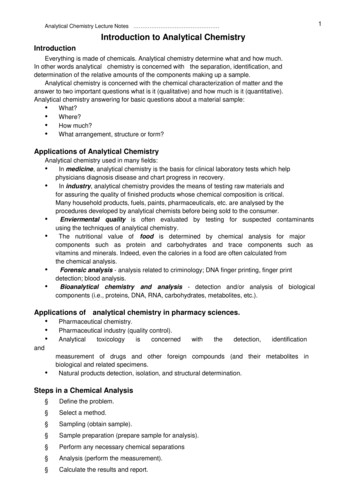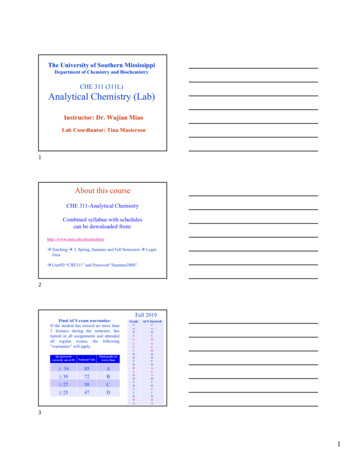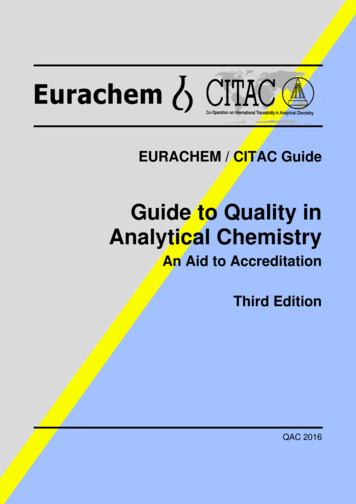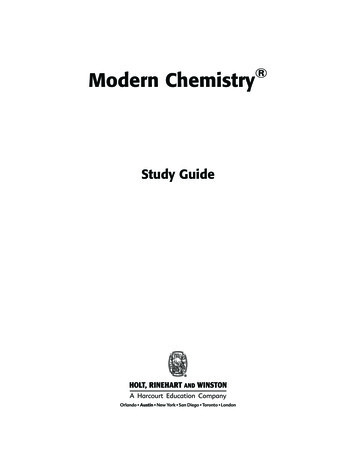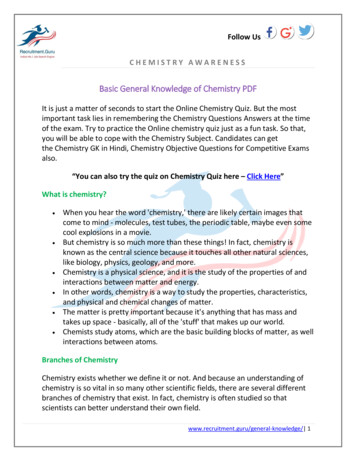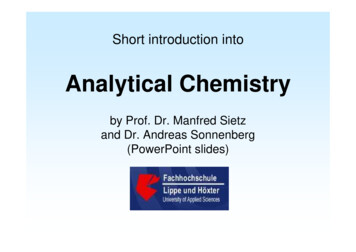
Transcription
110111011101110111011Analytical Chemistry
iiSection K – Lipid metabolismThe INSTANT NOTES seriesSeries editorB.D. HamesSchool of Biochemistry and Molecular Biology, University of Leeds, Leeds, UKAnimal BiologyBiochemistry 2nd editionChemistry for BiologistsDevelopmental BiologyEcology 2nd editionGeneticsImmunologyMicrobiologyMolecular Biology 2nd editionNeurosciencePlant BiologyPsychologyForthcoming titlesBioinformaticsThe INSTANT NOTES Chemistry seriesConsulting editor: Howard StanburyAnalytical ChemistryInorganic ChemistryMedicinal ChemistryOrganic ChemistryPhysical Chemistry
11Analytical Chemistry0111D. Kealey0111School of Biological and Chemical SciencesBirkbeck College, University of London, UKandDepartment of ChemistryUniversity of Surrey, Guildford, UKand0111P. J. HainesOakland Analytical Services,Farnham, UK0111011
BIOS Scientific Publishers Limited, 2002First published 2002 (ISBN 1 85996 189 4)This edition published in the Taylor & Francis e-Library, 2005.“To purchase your own copy of this or any of Taylor & Francis or Routledge’scollection of thousands of eBooks please go to www.eBookstore.tandf.co.uk.”All rights reserved. No part of this book may be reproduced or transmitted, in any form orby any means, without permission.A CIP catalogue record for this book is available from the British Library.ISBN 0-203-64544-8 Master e-book ISBNISBN 0-203-68109-6 (Adobe eReader Format)ISBN 1 85996 189 4 (Print Edition)BIOS Scientific Publishers Ltd9 Newtec Place, Magdalen Road, Oxford OX4 1RE, UKTel. 44 (0)1865 726286. Fax 44 (0)1865 246823World Wide Web home page: http://www.bios.co.uk/Distributed exclusively in the United States, its dependent territories, Canada, Mexico, Centraland South America, and the Caribbean by Springer-Verlag New York Inc, 175 Fifth Avenue,New York, USA, by arrangement with BIOS Scientific Publishers, Ltd, 9 Newtec Place,Magdalen Road, Oxford OX4 1RE, UK
C ONTENTS11AbbreviationsPrefaceviiixSection A – The nature and scope of analytical chemistryA1 Analytical chemistry, its functions and applicationsA2 Analytical problems and proceduresA3 Analytical techniques and methodsA4 Sampling and sample handlingA5 Calibration and standardsA6 Quality in analytical laboratories11351015180111Section B Assessment of dataB1Errors in analytical measurementsB2Assessment of accuracy and precisionB3Significance testingB4Calibration and linear regressionB5Quality control and chemometrics2121263441490111Section C Analytical reactions in solutionC1 Solution equilibriaC2 Electrochemical reactionsC3 PotentiometryC4 pH and its controlC5 Titrimetry I: acid–base titrationsC6 Complexation, solubility and redox equilibriaC7 Titrimetry II: complexation, precipitation and redoxtitrationsC8 GravimetryC9 Voltammetry and amperometryC10 Conductimetry5555616674808501110111011Section D Separation techniquesD1 Solvent and solid-phase extractionD2 Principles of chromatographyD3 Thin-layer chromatographyD4 Gas chromatography: principles and instrumentationD5 Gas chromatography: procedures and applicationsD6 High-performance liquid chromatography: principlesand instrumentationD7 High-performance liquid chromatography: modes,procedures and applicationsD8 Electrophoresis and electrochromatography: principlesand instrumentationD9 Electrophoresis and electrochromatography: modes,procedures and 2
viContentsSection E Spectrometric techniquesE1Electromagnetic radiation and energy levelsE2Atomic and molecular spectrometryE3Spectrometric instrumentationE4Flame atomic emission spectrometryE5Inductively coupled plasma spectrometryE6X-ray emission spectrometryE7Atomic absorption and atomic fluorescence spectrometryE8Ultraviolet and visible molecular spectrometry:principles and instrumentationE9Ultraviolet and visible molecular spectrometry:applicationsE10 Infrared and Raman spectrometry: principles andinstrumentationE11 Infrared and Raman spectrometry: applicationsE12 Nuclear magnetic resonance spectrometry: principlesand instrumentationE13 Nuclear magnetic resonance spectrometry: interpretationof proton and carbon-13 spectraE14 Mass spectrometry189189195201206209214218Section F Combined techniquesF1Advantages of combined techniquesF2Sample identification using multiple spectrometrictechniques dataF3Gas chromatography–mass spectrometryF4Gas chromatography–infrared spectrometryF5Liquid chromatography–mass 2Section G Thermal methodsG1 ThermogravimetryG2 Differential thermal analysis and differential scanningcalorimetryG3 Thermomechanical analysisG4 Evolved gas analysis305305Section H – Sensors, automation and computingH1 Chemical sensors and biosensorsH2 Automated proceduresH3 Computer control and data collectionH4 Data enhancement and databases323323328331333Further readingIndex337339311316320
A ICP-OES011atomic absorption spectrometryanalog-to-digital converteratomic fluorescence spectrometryanalysis of varianceattenuated total reflectancebonded-phase chromatographychiral chromatographycapillary gel electrophoresisconfidence intervalcapillary isoelectric focusingconfidence limitscentral processing unitcertified reference materialcapillary zone electrophoresisdigital-to-analog converterdiode array detectordynamic mechanical analysisdropping mercury electrodedifferential scanning calorimetrydifferential thermal analysisderivative thermogravimetrydigital voltmeterelectron-capture detectorenergy dispersive analysisof X-raysethylenediaminetetraacetic acidevolved gas analysisfactor analysisflame atomic emissionspectometryfast Fourier transformflame ionization detectoror free induction decaygas chromatographygas liquid chromatographygas solid chromatographyhorizontal attenuated totalreflectancehigh-performance liquidchromatographyion chromatographyinductively coupled plasmaICP-atomic emission spectrometryICP-optical emission SHESIMSPESPMESRMTCDTGTICTISABTLCTMAICP-mass spectrometryion-exchange chromatographyion-selective electrodelinear variable differentialtransformermicellar electrokineticchromatographymultiple internal reflectancemass spectrometrynear infrarednuclear-magnetic resonancenitrogen-phosphorus detectorpolycyclic aromatic hydrocarbonspaper chromatographyprincipal component analysisprincipal component regressionpolydimethylsiloxanepartial least squaresquality assurancequality controlrandom access memoryradiofrequencyrefractive indexread only memoryrelative molecular masssaturated calomel electrodesodium dodecyl sulfateSDS-polyacrylamide gelelectrophoresissolvent extractionsize-exclusion chromatographystandard hydrogen electrodeselected ion monitoringsolid phase extractionsolid phase microextractionstandard reference materialthermal conductivity detectorthermogravimetrytotal ion currenttotal ionic strength adjustmentbufferthin-layer chromatographythermomechanical analysis
P REFACEAnalytical chemists and others in many disciplines frequently ask questions such as: What is thissubstance?; How concentrated is this solution?; What is the structure of this molecule? The answers tothese and many other similar questions are provided by the techniques and methods of analyticalchemistry. They are common to a wide range of activities, and the demand for analytical data of achemical nature is steadily growing. Geologists, biologists, environmental and materials scientists,physicists, pharmacists, clinicians and engineers may all find it necessary to use or rely on some of thetechniques of analysis described in this book.If we look back some forty or fifty years, chemical analysis concentrated on perhaps three main areas:qualitative testing, quantitative determinations, particularly by ‘classical’ techniques such as titrimetryand gravimetry, and structural analysis by procedures requiring laborious and time-consuming calculations. The analytical chemist of today has an armoury of instrumental techniques, automated systemsand computers which enable analytical measurements to be made more easily, more quickly and moreaccurately.However, pitfalls still exist for the unwary! Unless the analytical chemist has a thorough understanding of the principles, practice and limitations of each technique he/she employs, results may be inaccurate, ambiguous, misleading or invalid. From many years of stressing the importance of followingappropriate analytical procedures to a large number of students of widely differing abilities, backgroundsand degrees of enthusiasm, the authors have compiled an up-to-date, unified approach to the study ofanalytical chemistry and its applications. Surveys of the day-to-day operations of many industrial andother analytical laboratories in the UK, Europe and the USA have shown which techniques are the mostwidely used, and which are of such limited application that extensive coverage at this level would beinappropriate. The text therefore includes analytical techniques commonly used by most analyticallaboratories at this time. It is intended both to complement those on inorganic, organic and physicalchemistry in the Instant Notes series, and to offer to students in chemistry and other disciplines some guidance on the use of analytical techniques where they are relevant to their work. We have not given extendedaccounts of complex or more specialized analytical techniques, which might be studied beyond first- andsecond-year courses. Nevertheless, the material should be useful as an overview of the subject for thosestudying at a more advanced level or working in analytical laboratories, and for revision purposes.The layout of the book has been determined by the series format and by the requirements of theoverall analytical process. Regardless of the discipline from which the need for chemical analysis arises,common questions must be asked: How should a representative sample be obtained?What is to be determined and with what quantitative precision?What other components are present and will they interfere with the analytical measurements?How much material is available for analysis, and how many samples are to be analyzed?What instrumentation is to be used?How reliable is the data generated?These and related questions are considered in Sections A and B.Most of the subsequent sections provide notes on the principles, instrumentation and applications ofboth individual and groups of techniques. Where suitable supplementary texts exist, reference is madeto them, and some suggestions on consulting the primary literature are made.We have assumed a background roughly equivalent to UK A-level chemistry or a US generalchemistry course. Some simplification of mathematical treatments has been made; for example, in thesections on statistics, and on the theoretical basis of the various techniques. However, the texts listedunder Further Reading give more comprehensive accounts and further examples of applications.
xPrefaceWe should like to thank all who have contributed to the development of this text, especially the manyinstrument manufacturers who generously provided examples and illustrations, and in particular PerkinElmer Ltd. (UK) and Sherwood Scientific Ltd. (UK). We would like also to thank our colleagues whoallowed us to consult them freely and, not least, the many generations of our students who foundquestions and problems where we had thought there were none!DKPJH
Section A – The nature and scope of analytical chemistryCHEMISTRY, ITSFUNCTIONS ANDAPPLICATIONSA1 A NALYTICALKey NotesDefinitionAnalytical chemistry is a scientific discipline used to study the chemicalcomposition, structure and behavior of matter.PurposeThe purpose of chemical analysis is to gather and interpret chemicalinformation that will be of value to society in a wide range of contexts.Scope andapplicationsQuality control in manufacturing industries, the monitoring of clinicaland environmental samples, the assaying of geological specimens, andthe support of fundamental and applied research are the principalapplications.Related topicsDefinitionAnalytical problems andprocedures (A2)Chemical sensors and biosensors(H1)Automated procedures (H2)Computer control and datacollection (H3)Data enhancement and databases(H4)Analytical chemistry involves the application of a range of techniques andmethodologies to obtain and assess qualitative, quantitative and structuralinformation on the nature of matter. Qualitative analysis is the identification of elements, species and/orcompounds present in a sample. Quantitative analysis is the determination of the absolute or relative amountsof elements, species or compounds present in a sample. Structural analysis is the determination of the spatial arrangement of atoms inan element or molecule or the identification of characteristic groups of atoms(functional groups). An element, species or compound that is the subject of analysis is known as ananalyte. The remainder of the material or sample of which the analyte(s) form(s) a partis known as the matrix.PurposeThe gathering and interpretation of qualitative, quantitative and structural information is essential to many aspects of human endeavor, both terrestrial andextra-terrestrial. The maintenance of, and improvement in, the quality of lifethroughout the world, and the management of resources rely heavily onthe information provided by chemical analysis. Manufacturing industries useanalytical data to monitor the quality of raw materials, intermediates and
2Section A – The nature and scope of analytical chemistryfinished products. Progress and research in many areas is dependent on establishing the chemical composition of man-made or natural materials, and themonitoring of toxic substances in the environment is of ever increasing importance. Studies of biological and other complex systems are supported by thecollection of large amounts of analytical data.Scope andapplicationsAnalytical data are required in a wide range of disciplines and situations thatinclude not just chemistry and most other sciences, from biology to zoology, butthe arts, such as painting and sculpture, and archaeology. Space exploration andclinical diagnosis are two quite disparate areas in which analytical data is vital.Important areas of application include the following. Quality control (QC). In many manufacturing industries, the chemicalcomposition of raw materials, intermediates and finished products needs tobe monitored to ensure satisfactory quality and consistency. Virtually allconsumer products from automobiles to clothing, pharmaceuticals and foodstuffs, electrical goods, sports equipment and horticultural products rely, inpart, on chemical analysis. The food, pharmaceutical and water industries inparticular have stringent requirements backed by legislation for major components and permitted levels of impurities or contaminants. The electronicsindustry needs analyses at ultra-trace levels (parts per billion) in relation to themanufacture of semi-conductor materials. Automated, computer-controlledprocedures for process-stream analysis are employed in some industries. Monitoring and control of pollutants. The presence of toxic heavy metals(e.g., lead, cadmium and mercury), organic chemicals (e.g., polychlorinatedbiphenyls and detergents) and vehicle exhaust gases (oxides of carbon,nitrogen and sulfur, and hydrocarbons) in the environment are health hazardsthat need to be monitored by sensitive and accurate methods of analysis, andremedial action taken. Major sources of pollution are gaseous, solid and liquidwastes that are discharged or dumped from industrial sites, and vehicleexhaust gases. Clinical and biological studies. The levels of important nutrients, includingtrace metals (e.g., sodium, potassium, calcium and zinc), naturally producedchemicals, such as cholesterol, sugars and urea, and administered drugs in thebody fluids of patients undergoing hospital treatment require monitoring.Speed of analysis is often a crucial factor and automated procedures have beendesigned for such analyses. Geological assays. The commercial value of ores and minerals is determinedby the levels of particular metals, which must be accurately established.Highly accurate and reliable analytical procedures must be used for thispurpose, and referee laboratories are sometimes employed where disputesarise. Fundamental and applied research. The chemical composition and structureof materials used in or developed during research programs in numerousdisciplines can be of significance. Where new drugs or materials with potentialcommercial value are synthesized, a complete chemical characterization maybe required involving considerable analytical work. Combinatorial chemistryis an approach used in pharmaceutical research that generates very largenumbers of new compounds requiring confirmation of identity and structure.
Section A – The nature and scope of analytical chemistryA2 A NALYTICALPROBLEMSAND PROCEDURESKey NotesAnalytical problemsAnalyticalproceduresRelated topicsSelecting or developing and validating appropriate methods of analysisto provide reliable data in a variety of contexts are the principal problemsfaced by analytical chemists.Any chemical analysis can be broken down into a number of stages thatinclude a consideration of the purpose of the analysis, the quality of theresults required and the individual steps in the overall analyticalprocedure.Analytical chemistry, its functionsand applications (A1)Sampling and sample handling(A4)Chemical sensors and biosensors(H1)Automated procedures (H2)Computer control and datacollection (H3)Data enhancement and databases(H4)AnalyticalproblemsThe most important aspect of an analysis is to ensure that it will provide usefuland reliable data on the qualitative and/or quantitative composition of a materialor structural information about the individual compounds present. The analytical chemist must often communicate with other scientists and nonscientists toestablish the amount and quality of the information required, the time-scale forthe work to be completed and any budgetary constraints. The most appropriateanalytical technique and method can then be selected from those available or newones devised and validated by the analysis of substances of known compositionand/or structure. It is essential for the analytical chemist to have an appreciationof the objectives of the analysis and an understanding of the capabilities of thevarious analytical techniques at his/her disposal without which the most appropriate and cost-effective method cannot be selected or developed.AnalyticalproceduresThe stages or steps in an overall analytical procedure can be summarized asfollows. Definition of the problem. Analytical information and level of accuracyrequired. Costs, timing, availability of laboratory instruments and facilities. Choice of technique and method. Selection of the best technique for therequired analysis, such as chromatography, infrared spectrometry, titrimetry,thermogravimetry. Selection of the method (i.e. the detailed stepwise instructions using the selected technique). Sampling. Selection of a small sample of the material to be analyzed. Wherethis is heterogeneous, special procedures need to be used to ensure that agenuinely representative sample is obtained (Topic A4).
4Section A – The nature and scope of analytical chemistry Sample pre-treatment or conditioning. Conversion of the sample into a formsuitable for detecting or measuring the level of the analyte(s) by the selectedtechnique and method. This may involve dissolving it, converting theanalyte(s) into a specific chemical form or separating the analyte(s) from othercomponents of the sample (the sample matrix) that could interfere with detection or quantitative measurements. Qualitative analysis. Tests on the sample under specified and controlledconditions. Tests on reference materials for comparison. Interpretation of thetests. Quantitative analysis. Preparation of standards containing known amountsof the analyte(s) or of pure reagents to be reacted with the analyte(s).Calibration of instruments to determine the responses to the standards undercontrolled conditions. Measurement of the instrumental response for eachsample under the same conditions as for the standards. All measurementsmay be replicated to improve the reliability of the data, but this has cost andtime implications. Calculation of results and statistical evaluation. Preparation of report or certificate of analysis. This should include asummary of the analytical procedure, the results and their statistical assessment, and details of any problems encountered at any stage during theanalysis. Review of the original problem. The results need to be discussed with regardto their significance and their relevance in solving the original problem.Sometimes repeat analyses or new analyses may be undertaken.
Section A – The nature and scope of analytical chemistryA3 A NALYTICALTECHNIQUESAND METHODSKey NotesAnalyticaltechniquesChemical or physico-chemical processes that provide the basis foranalytical measurements are described as techniques.Analytical methodsA method is a detailed set of instructions for a particular analysis using aspecified technique.Method validationA process whereby an analytical method is checked for reliability interms of accuracy, reproducibility and robustness in relation to itsintended applications.Related topicQuality in analytical laboratories (A6)AnalyticaltechniquesThere are numerous chemical or physico-chemical processes that can be used toprovide analytical information. The processes are related to a wide range ofatomic and molecular properties and phenomena that enable elements andcompounds to be detected and/or quantitatively measured under controlledconditions. The underlying processes define the various analytical techniques.The more important of these are listed in Table 1, together with their suitability forqualitative, quantitative or structural analysis and the levels of analyte(s) in asample that can be measured.Atomic and molecular spectrometry and chromatography, which togethercomprise the largest and most widely used groups of techniques, can be furthersubdivided according to their physico-chemical basis. Spectrometric techniquesmay involve either the emission or absorption of electromagnetic radiation overa very wide range of energies, and can provide qualitative, quantitative andstructural information for analytes from major components of a sample downto ultra-trace levels. The most important atomic and molecular spectrometrictechniques and their principal applications are listed in Table 2.Chromatographic techniques provide the means of separating the components of mixtures and simultaneous qualitative and quantitative analysis, asrequired. The linking of chromatographic and spectrometric techniques, calledhyphenation, provides a powerful means of separating and identifyingunknown compounds (Section F). Electrophoresis is another separation technique with similarities to chromatography that is particularly useful for theseparation of charged species. The principal separation techniques and theirapplications are listed in Table 3.AnalyticalmethodsAn analytical method consists of a detailed, stepwise list of instructions to befollowed in the qualitative, quantitative or structural analysis of a sample for oneor more analytes and using a specified technique. It will include a summary and
6Table 1.Section A – The nature and scope of analytical chemistryAnalytical techniques and principal applicationsTechniqueProperty measuredPrincipal areas of applicationGravimetryWeight of pure analyte or compoundof known stoichiometryQuantitative for major or minorcomponentsTitrimetryVolume of standard reagent solutionreacting with the analyteQuantitative for major or minorcomponentsAtomic and molecularspectrometryWavelength and intensity ofelectromagnetic radiation emitted orabsorbed by the analyteQualitative, quantitative or structuralfor major down to trace levelcomponentsMass spectrometryMass of analyte or fragments of itQualitative or structural for majordown to trace level componentsisotope ratiosChromatography andelectrophoresisVarious physico-chemical propertiesof separated analytesQualitative and quantitativeseparations of mixtures at major totrace levelsThermal analysisChemical/physical changes in theanalyte when heated or cooledCharacterization of single or mixedmajor/minor componentsElectrochemical analysisElectrical properties of the analytein solutionQualitative and quantitative for majorto trace level componentsRadiochemical analysisCharacteristic ionizing nuclearradiation emitted by the analyteQualitative and quantitative at majorto trace levelsTable 2.Spectrometric techniques and principal applicationsTechniqueBasisPrincipal applicationsPlasma emission spectrometryAtomic emission after excitation in hightemperature gas plasmaDetermination of metals and somenon-metals mainly at trace levelsFlame emission spectrometryAtomic emission after flame excitationDetermination of alkali and alkalineearth metalsAtomic absorption spectrometryAtomic absorption after atomizationby flame or electrothermal meansDetermination of trace metals andsome non-metalsAtomic fluorescencespectrometryAtomic fluorescence emission afterflame excitationDetermination of mercury andhydrides of non-metals at tracelevelsX-ray emission spectrometryAtomic or atomic fluorescenceemission after excitation by electronsor radiationDetermination of major and minorelemental components ofmetallurgical and geological samplesγ-spectrometryγ-ray emission after nuclear excitationMonitoring of radioactive elements inenvironmental samplesUltraviolet/visible spectrometryElectronic molecular absorption insolutionQuantitative determination ofunsaturated organic compoundsInfrared spectrometryVibrational molecular absorptionIdentification of organic compoundsNuclear magnetic resonancespectrometryNuclear absorption (change of spinstates)Identification and structural analysisof organic compoundsMass spectrometryIonization and fragmentation ofmoleculesIdentification and structural analysisof organic compounds
A3 – Analytical techniques and methodsTable 3.7Separation techniques and principal applicationsTechniqueBasisThin-layer chromatographyGas chromatographyHigh-performance liquidchromatographyElectrophoresis冧Principal applicationsQualitative analysis of mixturesDifferential rates of migration ofanalytes through a stationary phaseby movement of a liquid or gaseousmobile phaseDifferential rates of migration ofanalytes through a buffered mediumQuantitative and qualitativedetermination of volatile compoundsQuantitative and qualitativedetermination of nonvolatilecompoundsQuantitative and qualitativedetermination of ionic compoundslists of chemicals and reagents to be used, laboratory apparatus and glassware,and appropriate instrumentation. The quality and sources of chemicals,including solvents, and the required performance characteristics of instrumentswill also be specified as will the procedure for obtaining a representative sampleof the material to be analyzed. This is of crucial importance in obtaining meaningful results (Topic A4). The preparation or pre-treatment of the sample will befollowed by any necessary standardization of reagents and/or calibration ofinstruments under specified conditions (Topic A5). Qualitative tests for theanalyte(s) or quantitative measurements under the same conditions as those usedfor standards complete the practical part of the method. The remaining steps willbe concerned with data processing, computational methods for quantitativeanalysis and the formatting of the analytical report. The statistical assessment ofquantitative data is vital in establishing the reliability and value of the data, andthe use of various statistical parameters and tests is widespread (Section B).Many standard analytical methods have been published as papers in analytical journals and other scientific literature, and in textbook form. Collections bytrades associations representing, for example, the cosmetics, food, iron and steel,pharmaceutical, polymer plastics and paint, and water industries are available.Standards organizations and statutory authorities, instrument manufacturers’applications notes, the Royal Society of Chemistry and the US EnvironmentalProtection Agency are also valuable sources of standard methods. Often, laboratories will develop their own in-house methods or adapt existing ones forspecific purposes. Method development forms a significant part of the work ofmost analytical laboratories, and method validation and periodic revalidation isa necessity.Selection of the most appropriate analytical method should take into accountthe following factors: the purpose of the analysis, the required time scale and any cost constraints; the level of analyte(s) expected and the detection limit required; the nature of the sample, the amount available and the necessary samplepreparation procedure; the accuracy required for a quantitative analysis; the availability of reference materials, standards, chemicals and solvents,instrumentation and any special facilities; possible interference with the detection or quantitative measurement ofthe analyte(s) and the possible need for sample clean-up to avoid matrixinterference;
8Section A – The nature and scope of analytical chemistry the degree of selectivity available methods may be selective for a smallnumber of analytes or specific for only one; quality control and safety factors.Method validationAnalytical methods must be shown to give reliable data, free from bias and suitable for the intended use. Most methods are multi-step proce
analytical data to monitor the quality of raw materials, intermediates and Key Notes Analytical chemistry is a scientific discipline used to study the chemical composition, structure and behavior of matter. PurposeFile Size: 2MB
